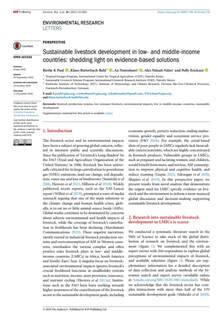 1. Introduction The livestock sector and its environmental impacts have been a subject of growing global concern, reflected in intensive public and scientific discussions. Since the publication of ‘Livestock’s Long Shadow’ by the FAO (Food and Agriculture Organization of the United Nations) in 2006, livestock has been universally criticized for its large contribution to greenhouse gas (GHG) emissions, land use change, soil degradation, water use and loss of biodiversity (Steinfeld et al 2006, Herrero et al 2015, Hilborn et al 2018). Widely publicized recent reports, such as the EAT-Lancet report (Willett et al 2019), prompted a wave of media outreach arguing that one of the main solutions to the climate change and human health crises, globally, is to eat no or little animal source foods (ASFs). Global media continues to be dominated by concerns about adverse environmental and health impacts of livestock, while the coverage of livestock’s contribution to livelihoods has been declining (Marchmont Communications 2019). These negative narratives, mostly rooted in industrial livestock production systems and overconsumption of ASF in Western countries, overshadow the various complex and often positive roles livestock plays in low- and middle income countries (LMICs) in Africa, South America and South(-East) Asia. A singular focus on livestock associated environmental impacts ignores livestock’s crucial livelihood functions in smallholder systems such as nutrition, income, asset provision, insurance, and nutrient cycling (Herrero et al 2013a). Institutions such as the FAO have been working towards higher awareness of the contributions of the livestock sector to the sustainable development goals, including economic growth, poverty reduction, ending malnutrition, gender equality and ecosystem service provision (FAO 2018). For example, the cereal-based diets of poor people in LMICs regularly lack bioavailable (micro)nutrients, which are highly concentrated in livestock products. Vulnerable groups in LMICs, such as pregnant and lactating women, and children, would benefit from more, and not less, ASF consumption to improve physical and cognitive health, and reduce stunting (Gupta 2016, Adesogan et al 2020, Shapiro et al 2019). In this perspective paper, we present results from novel analysis that demonstrate the urgent need for LMIC-specific evidence on livestock and the environment to inform a more nuanced global discussion and decision-making supporting sustainable livestock development.
0 Comments
Analysis of livestock and fodder value chains in arid and semi-arid lands in Kenya 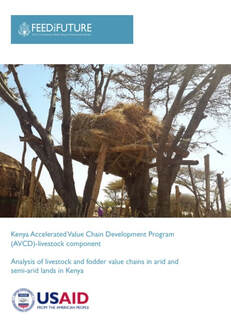 Executive summary As in many developing countries, the livestock revolution is real in Kenya which presents huge opportunities to improve the livelihoods of the pastoral community through improved production and marketing in the pastoral land-use system. To attain the promise of Vision 2030 and unlock the potential of arid and semi-arid lands in Kenya, intervention strategies and production systems need to be aligned with the ongoing change in: demand/consumption for animal-source foods (ASFs) and in the production environment. The average per capita red meat consumption in Kenya is about 15–16 kg, approximately 600,000MT2 of red meat nationally. Of this, about 80–86% comes from the pastoral production system, while 20–25% of the meat supply comes from the neighbouring countries (through formal and informal cross-border livestock trade) with Ethiopia, Somalia, Uganda and Tanzania. The Livestock component of the Accelerated Value Chain Development (AVCD) program recently undertook a livestock and fodder value chains analysis to the inform design and implementation of high impact and targeted interventions across five counties in northern Kenya (Isiolo, Garissa, Marsabit, Turkana and Wajir). Operating with the framework of the United States Agency for International Development (USAID)-funded Feed the Future Initiative in Kenya. The program promotes and upscales the utilization of improved technologies and innovations of selected value chains (livestock, dairy, and staple root and drought-tolerant crops) to competitively and sustainably increase productivity, promote agricultural growth and improve nutrition and food security, particularly among women and children. The International Livestock Research Institute (ILRI) leads the AVCD livestock value chain whose main goal is to increase incomes from the sales of livestock by 50% by 2018, lifting an additional 50,000 households in selected regions of Kenya out of poverty and improving their nutritional status. The Indian state of Odisha has officially rolled-out the process of designing a ‘livestock master plan’ (LMP) with the support of the International Livestock Research Institute (ILRI).
The process started on 22 Oct 2020 with a virtual inception meeting in which R Raghu Prasad, the commissioner-cum-secretary of the Fisheries and Animal Resources Department (FARD) of the Government of Odisha praised the initiative saying the LMP would help in leveraging the ‘tremendous opportunities for growth in the sector.’ The share of the livestock sector’s contribution to farmer’s incomes in the state has risen to the current 7% from 1.5% in 2000 and the Odisha LMP will focus on helping small-scale livestock farmer groups, semi-commercial and commercial farmer groups and other stakeholders benefit more from the sector. Livestock Emergency Guidelines and Standards (LEGS) is pleased to announce that the second webinar in its upcoming series is open for registration:
Nutrition and Livestock in Emergencies Tuesday 3rd November 2020 at 12 noon GMT Presenter: Dr Kate Sadler Malnutrition represents the single most important threat for children worldwide and brings about substantial impacts both on humans and economic potential. The webinar will review the key issues relating to human nutrition in the context of livestock-based emergency interventions, with particular attention to the following key topics:
Registration: Please register at the following link: https://us02web.zoom.us/webinar/register/WN_0Iz6tNhYR6yZZhvck4hA8g After registering, you will receive a confirmation email containing information about how to join the webinar. The LEGS Discussion Paper on Nutrition and Livestock in Emergencies, written by Dr Kate Sadler, will be available prior to the webinar on the LEGS website resources page and will also be advertised via the LEGS mailing list. We look forward to you joining us. Questions? Email: [email protected] LEGS is pleased to announce that the first webinar in its upcoming series is open for registration:
Gender and Livestock in Emergencies Thursday 15th October 2020 at 12 noon GMT (1pm British Summer Time) Presenters: Karin de Jonge and Lucy Maarse Understanding gender roles and addressing specific gender-related needs and vulnerabilities can lead to improved outcomes for livestock-based humanitarian action, in terms of protecting women’s assets, addressing their priorities, and overcoming cultural and economic barriers. The webinar will include a summary of current trends and thinking regarding gender and humanitarian action, and its relevance for livestock related humanitarian interventions. Registration: Please register at the following link: https://us02web.zoom.us/webinar/register/WN_6rIz4wMSRC26Q85DI1w8fQ After registering, you will receive a confirmation email containing information about how to join the webinar. The LEGS Discussion Paper on Gender and Livestock in Emergencies, written by Karin de Jonge and Lucy Maarse, will be available prior to the webinar on the LEGS website resources page and will also be advertised via the LEGS mailing list. We look forward to you joining us. On 22 June at 15:00 CEST, the FAO’s Livestock Environmental Assessment and Performance (FAO LEAP) Partnership will be hosting the webinar Biodiversity and the livestock sector. Mitigating harms and maximizing benefits, on the occasion of the launch of new guidelines on biodiversity.
The event will kick off with the opening remarks by special guests. The LEAP Biodiversity Technical Advisory Group (TAG) leader, Tim McAllister, will present the guidelines. Following a panel discussion with representatives from governments, the private sector, and civil society, participants will have the opportunity to comment and ask questions. The 90-minute webinar welcomes all livestock stakeholders interested in environmental assessment, including representatives from governments private sector, non-governmental organizations, civil society, investment organizations, standardization bodies, academia, research and foundations. Register here: https://fao.zoom.us/webinar/register/WN_oKlc68VMToKsf3zQS9kmew Read more: http://www.fao.org/partnerships/leap/news-and-events/events/webinars/biodiversity-and-the-livestock-sector/en/ Agenda 15:00 - 15:05 – Welcome address 15:05 - 15:25 – Opening remarks 15:25 - 15:45 – Keynote presentation – Biodiversity and the livestock sector. Guidelines for quantitative assessment 15:45 - 16:05 – Panel discussion – Application of the FAO LEAP biodiversity guidelines 16:05 - 16:25 – Q&A 16:25 - 16:30 – Closing remark Livestockdata.org offers data and evidence on livestock health and productivity in low and middle-income countries  A new website aims to communicate the best available data and evidence on livestock health and productivity. Launched today, Livestockdata.org is managed by Supporting Evidence Based Interventions (SEBI) on behalf of the Livestock Data for Decisions (LD4D) community of practice. According to SEBI, poor quality, scarce and disparate data are holding back development of the livestock sector in low and middle-income countries. This impacts the lives of millions of people who depend on livestock for a living. The new site aims to build up a knowledge base of open access data, interactive tools and visualisations that policy makers and investors can use to make evidence-based decisions. READ MORE… 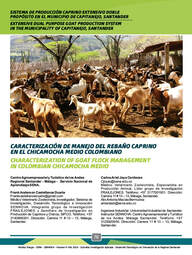 Descargar Descargar Resumen El Chicamocha Medio es una ecorregión donde la caprinocultura se considera una actividad económica importante para las familias campesinas, por ello se propuso identificar las prácticas de manejo del ganado caprino para generar información específica que sea útil para las instituciones en diferentes escenarios. Se tomó una muestra no probabilística a 33 unidades productivas caprinas de nueve municipios de esta región. El diagnóstico se realizó mediante una encuesta semiestructurada sobre como: 1. tipificación de predios, 2. acompañamiento técnico, 3. inventario de semovientes, 4. instalaciones para caprinos, 5. fin productivo, 6. manejo del rebaño, 7. Plan sanitario, 8. tipo de sistema productivo y alimentación y 9. Bioseguridad. Se estableció que la caprinocultura se desarrolla en minifundios con un inventario promedio de 59 cabezas, con infraestructura adaptada y baja inclusión tecnológica. El fin productivo predominante es la carne, su manejo es tradicional en sistema semi confinado y el principal problema sanitario referido es el parasitismo gastrointestinal. Se concluye que el manejo del rebaño es tradicional con baja inclusión tecnológica, los problemas sanitarios son de origen infeccioso y las soluciones ofrecidas a este renglón productivo son muy incipientes. LEE MAS... Un agradecimiento especial a Clara Viviana Rúa Bustamante por esta información. Extensive Dual Purpose Goat Production System in the Municipality of Capitanejo, Santander, Colombia6/26/2019 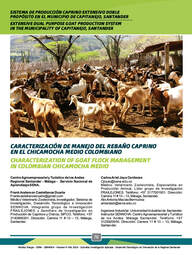 DOWNLOAD DOWNLOAD Abstract The Chicamocha Medio is an ecoregion where the goat culture is considered an important economic activity for the peasant families. Therefore, it was proposed to identify goat management practices to generate specific information that is useful for institutions in different scenarios. A non-probabilistic sample was taken from 33 goat production units from nine municipalities of this region. The diagnosis was made through a semi-structured survey on: 1. plots classification, 2. technical support, 3. livestock inventory, 4. goat facilities, 5. productive aim, 6. herd management, 7. sanitary plan, 8. type of productive system and food and 9. biosafety. It was established that the goat culture is developed in smallholdings with an average inventory of 59 heads, with adapted infrastructure and low technological inclusion. The predominant productive purpose is meat, its management is traditional in a semi-confined system and the main health problem referred to is gastrointestinal parasitism. It is concluded that the management of the flock is traditional with low technological inclusion, the sanitary problems are of infectious origin and the solutions offered to this productive line are very incipient. READ MORE… Special thanks to Clara Viviana Rúa Bustamante (Country Representative for Colombia) for this information. La Guajira es el departamento con mayor población ovinocaprina de Colombia, los animales han permanecido desde la época de la conquista en poder de las comunidades indígenas Wayúu, asentadas en la media y alta Guajira. Los sistemas de producción, la crianza y manejo de estos animales se adecúan a el ecosistema en el que viven y a la cultura de la etnia Wayúu, siendo para los occidentales una alternativa que ayuda a preservar de manera eficiente los recursos naturales. El Ministerio de Agricultura y Desarrollo Rural de Colombia y Agrosavia, investigan sobre la medicina tradicional y la proyección de estos sistemas a mercados internacionales. Un agradecimiento especial a Clara Viviana Rúa Bustamante (IGA-CR, Colombia) por esta información. |
IGA Blog
The International Goat Association promotes goat research and development for the benefit of humankind, to alleviate poverty, to promote prosperity and to improve the quality of life. Archives
May 2024
Categories
All
|
|
International Goat Association
2516 Millbrook Rd., Little Rock, AR72227 USA email: [email protected] -454-1641 |
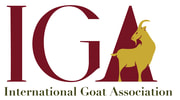
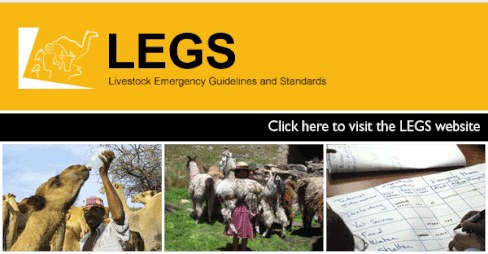
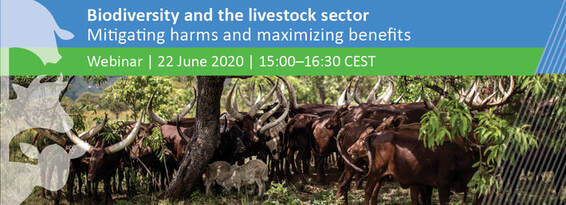
 RSS Feed
RSS Feed